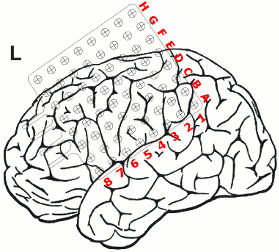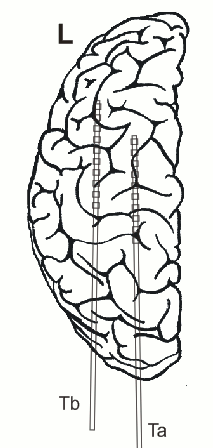ECoG tutorial
Dataset description
License
This tutorial dataset (EEG and MRI data) remains proprietary of the Epilepsy Centre, University Hospital Freiburg, Germany. Its use and transfer outside the Brainstorm tutorial, e.g. for research purposes, is prohibited without written consent from the Epilepsy Centre in Freiburg. For questions please contact A. Schulze-Bonhage, MD, PhD: andreas.schulze-bonhage@uniklinik-freiburg.de
Acknowledgements
We would like to thank the patient for providing his dataset for this tutorial, the clinical team of the Epilepsy Center Freiburg for the aquisition of the dataset and Verena Schulte for her help in preparing the dataset for the tutorial.
Clinical description
The patient is a 38yr male who suffered from drug resistant focal epilepsy since his 13th year of age with two different types of focal aware seizures that rarely evolved at nighttime to bilateral tonic-clonic seizures. Seizure type I consisted of daily aware focal seizures with myoclonic or clonic jerks of the right leg that occasionally led to falls. Type II consisted of formication paraesthesias that propagated from the right calf to the hip region. It could be provoked by stress or hot weather and occurred 2-3 times a week. In the presurgical 3T epilepsy MRI no structural abnormality was detected.
Implantation scheme
After non-invasive telemetry intracranial recordings were performed. It was decided to implant a 64 channels Ad-Tech subdural grid with 8x8 contacts (stainless steel, 10mm between centers of contacts, 2.3mm diameter exposure) over the left fronto-centro-parietal convexity covering the central region. The most inferior lateral row of contacts of the grid electrode is named A and the row of contacts next to the midline is named H. The contacts of the grid have numbers between 1-8 with the most posterior contacts of each row starting with number 1.
Additionally, 3 interhemispheric Ad-Tech strip electrodes with 4 contacts each named from posterior to anterior with IHA being the most posterior followed by IHB and IHC being the most anterior strip electrode. The numbering convention is that the deepest contact is named contact "1": and the most superficial contact of each electrode has the highest number.
In addition, 2 Ad-Tech sEEG electrodes were implanted in the right parietal lobe facing to the insula (TA & TB, distance between centers of contacts: 10mm, diameter: 0.86mm). Both sEEG electrodes have 10 electrode contacts each. The contacts are counted from anterior to posterior starting with contact number 1 at the tip of each sEEG electrode.
The figure illustrating the electrode positions was created as reported by Kovalev et al. 2005.



Recordings
The EEG data distributed here was recorded at 1024Hz, using a Neurofile NT digital video-EEG system with 128 channels and a 16-bit A/D converter. The signal was filtered in the recording system with a high-pass filter with a time constant of 1 second (cut-off frequency ~ 0.16Hz) and a low-pass filter with a cut-off frequency of 344 Hz.
Clinical evaluation
Interictal findings:
Repetitive sharp waves and interictal fast epileptic activity in the gamma frequency band (FEA; for advanced spectral analysis of FEA see also (Heers et al., 2018)) was almost continuously recorded in contacts G5-6 extending towards H5-6 or F5-6 and less frequently expanding to H3-4 & 7, IHA1-3, IHB1-3
Ictal findings:
- Seizure onset pattern: Repetitive gamma bursts interrupted by sharp slow waves in G5-6, H3-4 and IHA1-3
- Semiology: Myoclonic and clonic movements of the right leg intermingled with not clearly localizing habitual formication paraesthesias of the right leg
Electrical stimulation:
- Stimulation of contacts G5: habitual myoclonic seizures
- Stimulation of contact G6: habitual paraesthesias of the right leg
- Detailed function mapping was performed, which is not reported in detail here.
Resection, histopathology and postsurgical outcome:
- Resection of the posterior part of the superior frontal gyrus anterior of the precentral gyrus including the cingulate gyrus was performed. Because there was overlap between the primary motor cortex (confirmed by functional mapping) at contact H3 position H3, which was also involved in the seizure onset zone this brain area was spared and only multiple subpial transections were added here.
- Histological examination revealed focal cortical dysplasia type Ib (Palmini et al., 2004). After surgery the patient developed a severe SMA syndrome with diminished activity, problems in movement initiation and speech production from which he recovered completely after rehabilitation.
- After surgery the patient remained completely seizure free (Engel IA outcome, follow up 10 years).


References
Heers M, Helias M, Hedrich T, Dümpelmann M, Schulze-Bonhage A, Ball T (2018): Spectral bandwidth of interictal fast epileptic activity characterizes the seizure onset zone. NeuroImage Clin 17.
Kovalev D, Spreer J, Honegger J, Zentner J, Schulze‐Bonhage A, Huppertz HJ (2005): Rapid and fully automated visualization of subdural electrodes in the presurgical evaluation of epilepsy patients. AJNR Am J Neuroradiol 26:1078–1083.
Palmini A, Najm I, Avanzini G, Babb T, Guerrini R, Foldvary-Schaefer N, Jackson G, Luders HO, Prayson R, Spreafico R, Vinters H V (2004): Terminology and classification of the cortical dysplasias. Neurology 62:S2-8.
Files
The dataset we distribute with this tutorial follows the Brain Imaging Data Structure (BIDS) standard for neuroimaging data organization. This specification was first established for MRI and fMRI (Gorgolewski, 2016) and then refined with an extension dedicated to iEEG (Holdgraf, 2019). The files that will be imported in this tutorial are the following:
sample_ecog/
derivatives/: Everything that cannot be considered as raw data
freesurfer/sub-ecog01_ses-preimp/: Result of the FreeSurfer 7.1.1 segmentation for subject ecog01 (T1 pre-implantation)
sub-ecog01/: Raw data for subject ecog01
ses-preimp/: Imaging exams performed before the implantation of the ECoG/sEEG.
anat/sub-ecog01_ses-preimp_T1w.nii.gz: T1-weighted MRI pre-implantation
ses-postimp/: Exams performed with the sEEG/ECoG devices implanted.
anat/sub-ecog01_ses-postimp_T1w.nii.gz: T1-weighted MRI post-implantation
ieeg/..._task-seizure_run-01_ieeg.eeg: 1 hour ECoG+sEEG recordings with 3 seizures (saved using the BrainVision file format, with the header files .vhdr and .vmrk)
ieeg/..._space-IXI549Space_electrodes.tsv: Position of the contacts in MNI space (SPM12 Segment non-linear normalization)
ieeg/..._space-other_electrodes.tsv: Position of the contacts in world coordinates
All the anatomical images have been de-identified with mri_deface from FreeSurfer 6.